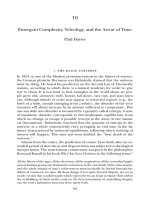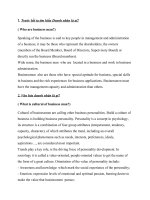The importance of value of time studies a dutch perspective
Bạn đang xem bản rút gọn của tài liệu. Xem và tải ngay bản đầy đủ của tài liệu tại đây (1.02 MB, 39 trang )
The 2013 national Dutch value of time study
Gerard de Jong – Significance and ITS Leeds
29 October 2015
and reliability
The 2013 national Dutch value of time study
Gerard de Jong – Significance and ITS Leeds
29 October 2015
Contents
1. What’s the question?
2. Data collection:
I.
II.
The 2009 SP data: internet panel
The 2011 SP data: en-route recruitment
3. Model estimation
4. Impact of recruitment method
5. The recommended values
6. A fair comparison of the 1997 and 2009/2011 VTT
3
Why do we need a VTT?
In many countries, transport projects (e.g. new road or railway line) are
evaluated ex ante using cost-benefit analysis (CBA)
In CBA project effects are expressed in money units
Costs include construction, maintenance and external cost
Main benefit often is travel time saved
□
There could also be journey time reliability benefits (often still ignored)
This is in hours or minutes, so we need a conversion factor to money
□
This factor is called the value of travel time VTT (e.g. in euros per hour)
4
The context: CBA of transport projects
Costs
Benefits
Construction costs
Time benefits: Pt*Qt
Pt: Value of travel time VTT
Qt: from transport model
Change in maintenance
costs
Reliability benefits: Pr*Qr
Change in external costs
Other transport cost savings
Pr: Value of travel time variability VTTV
Qr: forecasting model or surcharge
From transport model
…
…
…
…
5
The new national study
The objective of this project, for the Dutch Ministry of Infrastructure and the
Environment, was:
to provide values of time (update) and travel time reliability (first Dutch empiricallybased values) for passenger and freight transport by mode that can be used in costbenefit analysis (CBA) of transport projects
The project was completed and the report was officially released in June 2013)
(weblink at the end); the values are now official: used in all national transport
projects
In The Netherlands the VTT and VTTV are specifically for use in CBA, not for
inputs into transport forecasting models
The Netherlands also had national VTT studies (passengers) in 1988-1990 and
1997-1998
6
What’s the question?
This presentation is about the passenger transport component of the study
Values of time (VTTS) in passenger transport nowadays mainly come from
Stated Preference (SP) surveys
(see international meta-analysis by Wardman et al., 2012)
Different interview methods:
□
□
□
□
Mailback (pen and paper/cards)
CAPI (used for freight transport)
CATI
Internet
Recruitment method:
− Project-specific recruitment (e.g. en-route)
− From existing internet panel
7
Initial choice of interview and recruitment
method (2009 data)
The SP surveys required considerable customisation
□
Mailback can only provide this through extensive two-step procedures
CAPI and CATI were considered too expensive for a large survey (labour
cost)
Initial choice: internet survey using an existing internet panel
8
2009 survey procedure (1)
5,760 members of an existing on-line panel were interviewed using
computerised stated preference interviews in November 2009
Specific target numbers of interviews were set (and reached) for different
segments:
□
□
□
□
Transport mode used (car, train/metro, bus/tram, airplane and recreational
navigation)
Travel purpose (commuting, business, other)
Time-of-day (peak, off-peak)
Presence of transfers (public transport only)
All respondents were asked which modes they had used in the past three
months, etc.
□
This was used to allocate respondents to questionnaires for specific segments
9
2009 survey procedure (2)
All respondents were drawn from the largest on-line panel of The
Netherlands (240.000 participants)
The survey could be started by clicking on a weblink
The members received a reward for successfully completing the interview
(equivalent to €1.50)
The interviews on average took 20 minutes
10
Example of an SP choice screen (exp. 1)
11
Example of an SP choice screen (exp. 2a)
12
Initial results (2009 data)
VOTs implausibly low
□
□
About € 4 per hour for car and public transport
Substantially lower than the official values (about € 9 per hour) and the
international literature
Checked for possible explanations:
□
□
□
□
□
□
□
socio-economic composition of sample
travel time distribution of sample
changes in the statistical design of the SP
Including reliability in the SP
Increased use of mobile phones, smartphones
Impact of economic crisis
Increase in congestion
These only explained part of the differences with the official values
13
But there could be another explanation …
The sample of respondents obtained from this internet panel might be
biased with respect to their value of time
Within each segment (socio-economic, trip purpose, trip length, mode),
the respondents that participate in such an online panel (which takes time,
for a rather low monetary reward) might have a lower VOT than a nonparticipant
This is a self-selection problem
Even after expansion, the resulting values of time would then be lower
than the true values of time
To investigate this hypothesis, another data set was collected in the first
half of 2011
14
The 2011 SP data: en-route recruitment
Almost 1500 respondents recruited at petrol stations, parking garages,
train stations, bus stops, airports and ports
This is the same recruitment method as in earlier national value of time
surveys of 1988/1990 and 1997/1998
Persons willing to participate were asked to answer an internet
questionnaire on the intercepted trip:
□
□
Almost identical to the questionnaire used in 2009
We only asked one additional question to determine whether they were a
member of an internet panel (and whether this was “our” internet panel)
15
2011 Models distinguishing members/nonmembers of internet panels
MNL models
Advanced MNL models that:
□
□
yield a higher VTT for higher base time and cost levels, and
smaller VTTs for smaller changes offered in time and cost
Advanced MNL with socio-economic interaction terms
Advanced MNL with socio-economic interaction terms plus latent VTT
classes (LC model)
16
Linear versus non-linear time and cost
effects in the utility function
Utility function 1997:
Utility function 2009/2011:
17
4. Results for MNL model
Mode
Purpose
Relative VTT for panel member
(non-member=1)
MNL
Commuting
0.61
Business
0.93
Other
0.90
Airplane
All
1.07
Recr. navigation
Other
(0.96)
Car/train/BTM
Adv MNL
Adv MNL +
socio
Latent
class
18
4. Results for MNL models
Mode
Purpose
Relative VTT for panel member
(non-member=1)
MNL
Advanced
MNL
Commuting
0.61
0.80
Business
0.93
0.88
Other
0.90
0.93
Airplane
All
1.07
0.82
Recr. navigation
Other
(0.96)
(0.98)
Car/train/BTM
19
4. Results for MNL models
Mode
Purpose
Relative VTT for panel member
(non-member=1)
MNL
Advanced
MNL
Adv.MNL w.
interaction
Commuting
0.61
0.80
0.80
Business
0.93
0.88
0.87
Other
0.90
0.93
(1.01)
Airplane
All
1.07
0.82
0.82
Recr. navigation
Other
(0.96)
(0.98)
(0.98)
Car/train/BTM
20
4. Results for MNL and LC models
Mode
Purpose
Relative VTT for panel member
(non-member=1)
MNL
Advanced
MNL
Adv.MNL w.
interaction
Latent
class
Commuting
0.61
0.80
0.80
0.80
Business
0.93
0.88
0.87
(0.81)
Other
0.90
0.93
(1.01)
(0.89)
Airplane
All
1.07
0.82
0.82
0.82
Recr. navigation
Other
(0.96)
(0.98)
(0.98)
(0.95)
Car/train/BTM
21
4. Results for panel members 2009 and 2011
Mode
Purpose
Relative VTT for panel member
(non-member=1)
Advanced MNL 2009
(‘our’ panel)
Advanced MNL
2011 (all panels)
Commuting
0.64
0.80
Business
0.66
0.88
Other
0.74
0.93
Airplane
All
0.70
0.82
Recr. navigation
Other
(1.06)
(0.98)
Car/train/BTM
22
Discussion of results: does it matter/help? (1)
Especially for commuting (car, train, bus, tram, metro): significant lower
values for panel members,
□
even after correcting for the different distributions for the travel time and travel
cost, and after inclusion of the socio-economic interactions
Similar findings for the business and for airplane segment
Other purposes and recreational navigation: no significant difference
between panel and non-panel
We conclude that in the 2009 survey there was a bias towards low-VTT
persons, who are willing to give up time to participate in an internet panel
and to fill out web questionnaires for a rather small reward
23
Discussion of results: does it matter/help? (2)
The resulting VTTs from the 2011 survey are much more in line with the
values found in 1988/1990 and 1997/1998,
□
□
which have always been regarded as very plausible by the various transport
sectors,
and are not considered to be particularly high in an international perspective
Our conclusion is that the most likely explanation is that the 2011 values
are correct and that the 2009 values are biased downwards
24
The final VTT results are based on a
combination of the 2009 and 2011 data
The base VTT and VTTV levels come from estimates on the 2011 data
Socio-economic interaction effects and the effect of the base time and
cost levels as well as of changes in time and cost offered in the SP are
estimated on 2009 and 2011
Also: latent class models used here, and expansion of the estimation
results to the population (in hours travelled) using the 2010 national travel
survey (OViN)
This yields the recommended values for use in CBA
25









